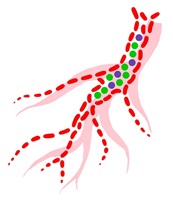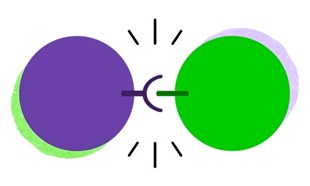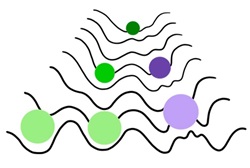Research
Targeting leukemia-associated monocytes in high-risk B-ALL
 B-ALL remodels the microenvironment around the leukemia to alter monocyte differentiation. Leukemia-associated monocyte abundance predicts pediatric and adult B-ALL patient survival and supports B-ALL progression and treatment evasion (Witkowski et al. Cancer Cell 2022)
B-ALL remodels the microenvironment around the leukemia to alter monocyte differentiation. Leukemia-associated monocyte abundance predicts pediatric and adult B-ALL patient survival and supports B-ALL progression and treatment evasion (Witkowski et al. Cancer Cell 2022)
Project Goals
- Determine function of leukemia-supporting nonclassical monocytes.
- Establish immune-based therapeutic approaches to improve conventional B-ALL therapy.
Improving T-cell immunotherapy by "tuning up" B-ALL surface protein levels
 Emerging
therapies allow a B-ALL patient's own T cells to be trained to recognize and kill B-ALL blasts. The B-ALL blast cell surface is often littered with a protein known as CD19, which is detected and bound by B-ALL-seeking T cells to kill the leukemic
cell target. However, blasts expressing low surface CD19 levels may fail to be found and destroyed.
Emerging
therapies allow a B-ALL patient's own T cells to be trained to recognize and kill B-ALL blasts. The B-ALL blast cell surface is often littered with a protein known as CD19, which is detected and bound by B-ALL-seeking T cells to kill the leukemic
cell target. However, blasts expressing low surface CD19 levels may fail to be found and destroyed.
Project Goals
- Identify gene pathways limiting surface CD19 levels on B-ALL blasts.
- Generate targeted approaches “tuning up” B-ALL surface CD19 levels for increased T cell killing.
Generate humanized B-ALL mouse models of high-risk disease
 Leukemia mouse models have proven to be an invaluable tool for exploring new treatment options for hematological malignancies, however, there are limited ALL mouse models that mimic the genetic and gene expression features of B-ALL cells in human patients in vivo.
Leukemia mouse models have proven to be an invaluable tool for exploring new treatment options for hematological malignancies, however, there are limited ALL mouse models that mimic the genetic and gene expression features of B-ALL cells in human patients in vivo.
Project Goals (collaboration with Flores-Diaz laboratory - UCSF)
- In-depth single cell analysis of high-risk B-ALL evolution.
- Humanized B-ALL mouse models utilizing CRISPR/Cas9 targeted genetic approaches.
| CONTACT US |
| Pediatrics Hematology/Oncology/Bone Marrow Transplant Laboratories Research Complex One North P18 Room 4403G 12800 East 19th Avenue Aurora, CO 80045 [email protected] Phone: 303.724.4634 |